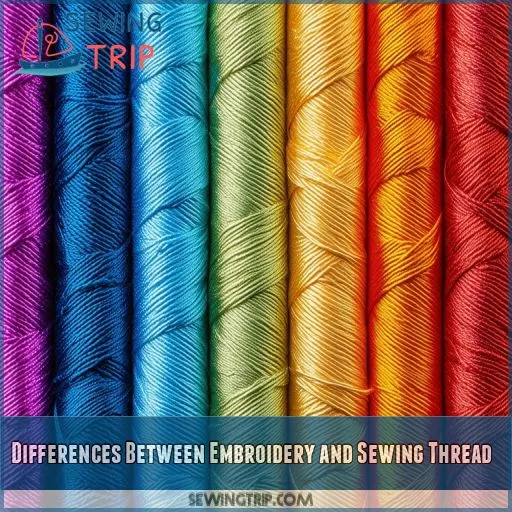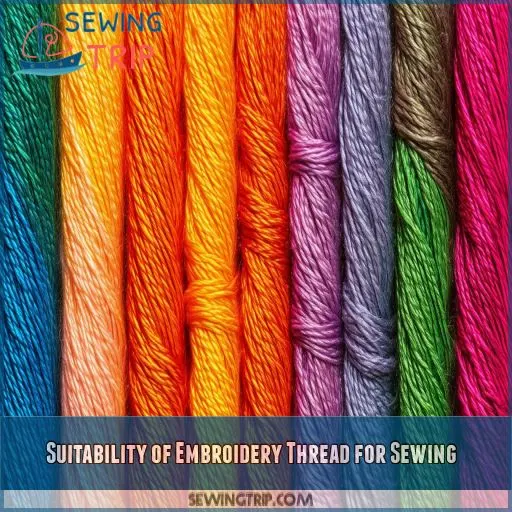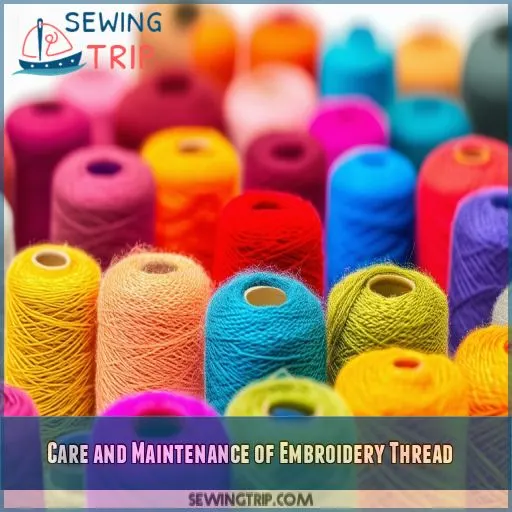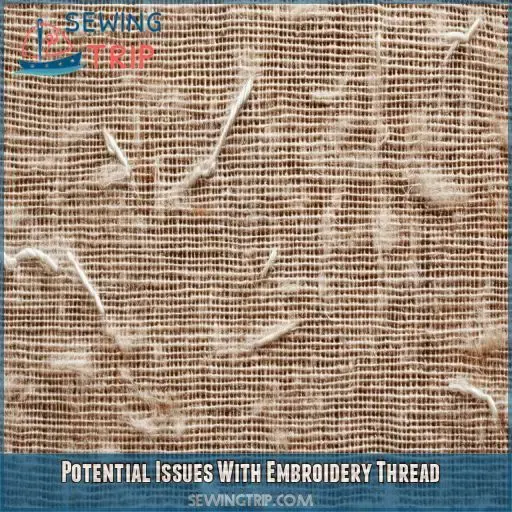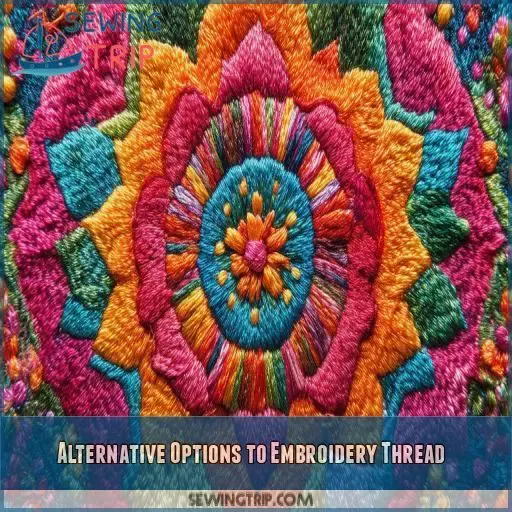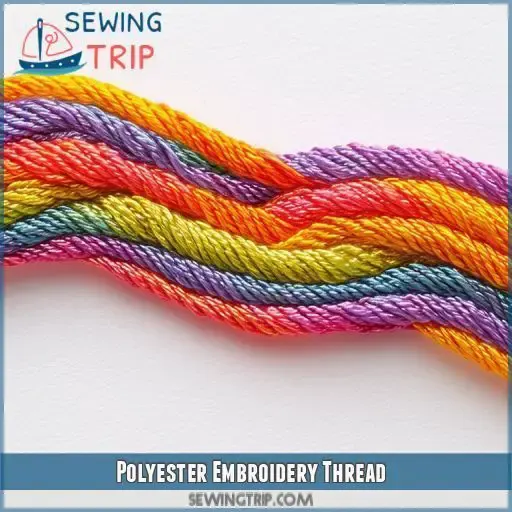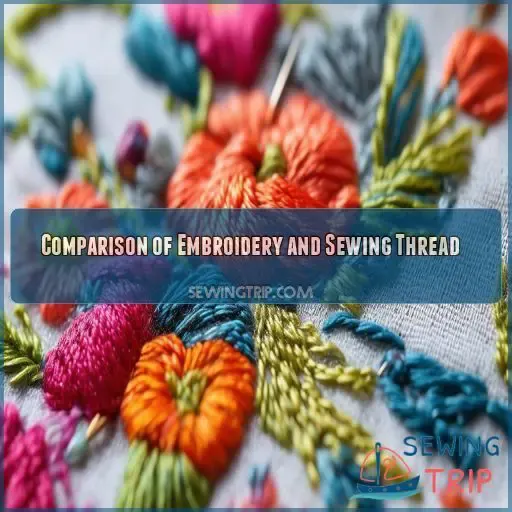This site is supported by our readers. We may earn a commission, at no cost to you, if you purchase through links.
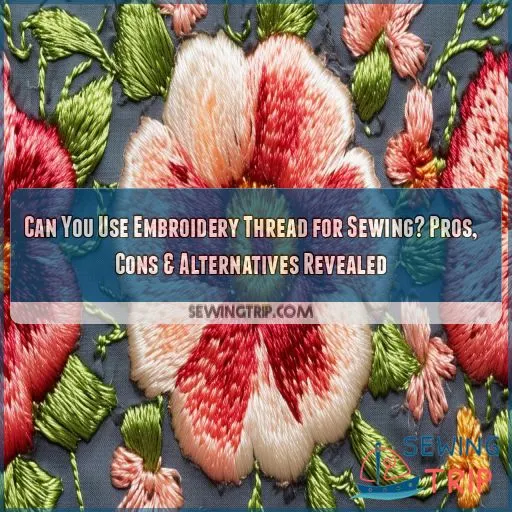
It’s suitable for topstitching, coverstitching, and buttonholes, but not ideal for garment construction. Keep in mind that embroidery thread requires gentler care and may shred more easily.
Before using it on garments, test the seam strength and avoid using it on children’s clothing or tight-fitting items.
If you’re looking for alternatives, consider regular sewing thread, bobbin thread, or quilting thread.
There’s more to uncover about this thread dilemma.
Table Of Contents
- Key Takeaways
- Can You Use Embroidery Thread for Sewing?
- Differences Between Embroidery and Sewing Thread
- Suitability of Embroidery Thread for Sewing
- Care and Maintenance of Embroidery Thread
- Potential Issues With Embroidery Thread
- Alternative Options to Embroidery Thread
- Polyester Embroidery Thread
- Comparison of Embroidery and Sewing Thread
- Frequently Asked Questions (FAQs)
- Conclusion
Key Takeaways
- Embroidery thread can be your sewing sidekick, but it’s not exactly Superman – it’s great for jazzing up your projects with topstitching and buttonholes, but it might leave you in a tight spot for garment construction.
- Treat your embroidery thread like a delicate flower – it needs extra TLC when cleaning and isn’t cut out for the rough-and-tumble world of kids’ clothes or skin-tight fashion statements.
- Your wallet might feel a bit lighter if you go all-in on embroidery thread, but hey, sometimes beauty comes at a price. Just remember to weigh the cost against the wow factor it brings to your creations.
- Before you dive headfirst into using embroidery thread for sewing, give it a test run. Think of it as a first date – you want to make sure you’re compatible before committing to a long-term relationship with your fabric project.
Can You Use Embroidery Thread for Sewing?
Yes, you can use embroidery thread for sewing, but it’s not ideal for constructing garments due to its expense and weaker tensile strength compared to sewing thread. However, embroidery thread can be suitable for topstitching, coverstitching, and buttonholes, as long as you take extra care when cleaning and test seam strength beforehand.
Differences Between Embroidery and Sewing Thread
When choosing between embroidery and sewing thread, you’ll notice some key differences. Embroidery thread has a looser twist, making it ideal for decorative stitching, while sewing thread boasts better tensile strength, ensuring your seams stay secure.
Twist: Embroidery Thread Has a Looser Twist
When you’re comparing embroidery thread to sewing thread, one key difference is the twist. Embroidery thread has a looser twist, which affects how it performs in your sewing machine and impacts your design choices.
This looser twist allows embroidery thread to create smoother, more lustrous stitches, perfect for decorative work. However, it also means the thread can unravel more easily, potentially affecting seam strength.
The twist also influences thread weight, with embroidery thread often being lighter and more delicate.
Understanding this difference is important when deciding between embroidery and sewing thread for your fabric projects, especially in machine embroidery where thread characteristics greatly impact the final result.
Strength: Sewing Thread Has Better Tensile Strength
While embroidery thread has a looser twist, sewing thread boasts superior tensile strength. This difference is important when it comes to your sewing endeavors. Sewing thread’s greater strength makes it perfect for constructing garments and withstanding the stress of everyday use. You’ll find that sewing thread:
- Holds up better in high-stress areas like seams and waistbands
- Provides more reliable fabric suitability for various projects
- Offers better machine compatibility, especially for regular sewing machines
The thickness difference between these thread types also plays a part. Sewing thread’s typically thinner profile allows for smoother stitching and less bulk in seams, contributing to its overall strength advantage in most sewing applications.
Suitability of Embroidery Thread for Sewing
While embroidery thread isn’t ideal for constructing garments due to its expense and relative weakness, you can use it for certain sewing tasks. It’s suitable for topstitching, coverstitching, and creating buttonholes, adding a decorative touch to your projects.
Not Ideal for Construction Due to Expense and Weakness
While embroidery thread can add a beautiful touch to your projects, it’s not your go-to for garment construction. Here’s why:
| Factor | Embroidery Thread | Sewing Thread |
|---|---|---|
| Strength | Weaker | Stronger |
| Cost | More expensive | More affordable |
| Durability | Less durable | More durable |
| Suitability | Decorative | Structural |
| Ease of Use | Can be finicky | User-friendly |
You’ll find embroidery thread’s weakness and higher price tag make it unsuitable for seams that need to withstand daily wear and tear. It’s designed for decorative purposes, not the structural integrity your garments require. Stick to regular sewing thread for construction – it’s stronger, cheaper, and built to last.
Can Be Used for Topstitching, Coverstitching, and Buttonholes
While embroidery thread isn’t ideal for construction, you can use it for decorative purposes. Here’s where it shines:
- Topstitching: Create eye-catching seams on garments or accessories
- Coverstitching: Add a professional finish to hems and edges
- Buttonholes: Craft unique, personalized closures
- Decorative stitching: Enhance your projects with intricate designs
Before using embroidery thread for these tasks, always stress test your seams. Remember, it’s not as strong as regular sewing thread. For best results, use it on areas that won’t face constant strain. When in doubt, compare sewing thread vs embroidery thread for your specific project. With careful application, you can leverage embroidery thread’s unique properties to elevate your sewing game.
Care and Maintenance of Embroidery Thread
When using embroidery thread for sewing, you’ll need to take extra care during cleaning and always test seam strength before using it on garments. It’s best to avoid using embroidery thread on children’s clothing or tight-fitting garments, as it may not withstand the stress and wear these items typically endure.
Requires Extra Gentle Care When Cleaning
When using embroidery thread for hand stitching or crewel work, you’ll need to treat your creations with extra care.
Rayon and polyester threads, known for their sheen, require gentle cleaning to maintain their luster. Unlike wool sewing thread or silk thread, embroidery threads can be delicate.
Embroidery artists often recommend hand-washing or dry-cleaning items with intricate designs.
Always check the thread manufacturer’s guidelines for specific care instructions to keep your work looking pristine.
Test Seam Strength Before Using on Garments
Before using embroidery thread for sewing, it’s essential to test its strength. You’ll want to guarantee it can withstand the stress your garment will face. Here’s how to assess durability:
- Create a test seam on scrap fabric
- Pull the seam in different directions
- Check for thread breakage or fabric tearing
Consider fabric type, thread weight, and stress-prone areas. Don’t forget to adjust your sewing machine’s thread path and needle selection for best results. This simple test can save you from future wardrobe malfunctions!
Avoid Using on Garments for Children or Tight Fits
When using embroidery thread for sewing, you’ll want to avoid it on children’s garments or tight-fitting clothes. These items often face more stress and movement, which can lead to tension issues and seam failure.
The decorative nature of embroidery thread isn’t ideal for thin fabrics or areas that need extra durability.
Stick to regular sewing thread for these projects, and save your embroidery thread for decorative stitching and embroidery designs where its beauty can truly shine.
Potential Issues With Embroidery Thread
You’ll find that embroidery thread can shred more easily than regular sewing thread, which may lead to frustrating breakages during your project. Additionally, embroidery thread tends to be more expensive than standard sewing thread, potentially increasing your overall project costs.
Can Shred Easily
When using embroidery thread for sewing, you’ll need to be cautious as it can shred easily. This fragility can lead to frustrating breakages during your project. To avoid this issue, consider these factors:
- Machine compatibility: Adjust tension settings carefully
- Bobbin use: Opt for a lighter weight thread in the bobbin
- Color selection: Choose threads that complement your fabric
Can Be Expensive
You’ll find that embroidery thread can put a dent in your wallet. It’s often pricier than regular sewing thread, especially when you’re eyeing those fancy metallic or silk varieties. Let’s break down the costs:
| Thread Type | Cost Range | Value for Money | Budget-Friendly? |
|---|---|---|---|
| Cotton | $2 – $5 | High | Yes |
| Rayon | $3 – $8 | Medium | Moderate |
| Metallic | $5 – $15 | Low | No |
| Nylon | $3 – $7 | Medium | Moderate |
When facing budget constraints, consider your project’s needs. Is the sheen of embroidery thread worth the extra cost? For everyday sewing, standard thread might be your best bet. But for those special projects, splurging on embroidery thread could be worth every penny.
Alternative Options to Embroidery Thread
Given the issues with embroidery thread, you might consider these alternatives.
For regular sewing, opt for all-purpose thread – it’s budget-friendly and strong enough for most projects. If you’re set on using embroidery thread, stick to embellishment only.
For topstitching, try 40 wt embroidery thread, but test it first.
Don’t forget about specialized options like bobbin thread for lightweight fabrics, serger thread for overlocking, or quilting thread for intricate designs.
Polyester Embroidery Thread
Polyester embroidery thread, designed for high-speed machines, offers strength that can be suitable for certain sewing tasks like topstitching on tencel skirts. However, you’ll need to test seams carefully before using it on garments, as it may not be appropriate for all types of clothing or construction.
Strong Due to High Speed of Embroidery Machines
While alternatives exist, polyester embroidery thread shines due to its strength. High-speed embroidery machines demand resilient threads, and polyester delivers. Here’s why it’s a top choice:
- Withstands rapid needle movement
- Resists breakage under tension
- Maintains integrity through multiple stitches
- Adapts well to various fabric types
Can Be Used for Topstitching on Tencel Skirts
You can use polyester embroidery thread for topstitching on tencel skirts, adding a touch of sheen to your project. Its loose twist gives a decorative finish that’s perfect for visible seams. While it’s pricier than regular thread, the elegant look it creates on your tencel garment can be worth the expense.
Test Seams Before Using on Garments
While polyester embroidery thread can be used for topstitching, it’s essential to test seams before committing to a full garment. This step is vital for ensuring the success and durability of your project. Here are key points to bear in mind:
- Check bobbin compatibility with your embroidery machine
- Test on stress points such as armholes and waistbands
- Evaluate thread performance in intricate designs
- Assess sheen impact on overall appearance
- Verify thread strength under various tensions
May Not Be Suitable for All Garments
While polyester embroidery thread can be versatile, it’s not a one-size-fits-all solution. After testing seams, consider the garment type before using it for sewing. Here’s a quick guide:
| Garment Type | Suitable for | Not Suitable for |
|---|---|---|
| Casual wear | Topstitching | Construction |
| Formal wear | Buttonholes | Waistbands |
| Home decor | Coverstitching | High-stress areas |
Comparison of Embroidery and Sewing Thread
While polyester embroidery thread is robust, it’s vital to comprehend how it compares to regular sewing thread. You’ll notice some key differences:
- Embroidery thread has a higher sheen, perfect for vintage aesthetics
- Sewing thread offers better tensile strength for high-stress applications
- Thread weight equivalency varies, with embroidery thread typically finer
When it comes to embroidery machine compatibility, embroidery thread is the clear winner. However, color matching can be trickier with embroidery thread due to its wider range of hues. Remember, while embroidery thread can be used for some sewing tasks, it’s not always the best choice for construction.
Frequently Asked Questions (FAQs)
Can I use embroidery thread in a regular sewing machine?
Like a fish out of water, embroidery thread can struggle in a regular sewing machine. You can use it, but it’s not ideal. It’s thinner and more delicate, potentially causing tension issues and breakage during normal sewing.
Is there a difference between sewing and embroidery thread?
Yes, there’s a clear difference. Sewing thread is stronger and designed for construction, while embroidery thread has a higher sheen and is meant for decorative purposes. You’ll notice embroidery thread is typically thinner with a looser twist.
Can you use embroidery thread on clothes?
You can use embroidery thread on clothes, but it’s not ideal for construction. It’s best for decorative stitching, topstitching, and buttonholes. Be cautious with garments that’ll experience stress, and always test seam strength before using it extensively.
Can you hand sew with embroidery floss?
Thread lightly when considering hand sewing with embroidery floss. You can use it, but it’s not ideal. It’s thicker and less durable than regular sewing thread. For best results, stick to decorative stitches or small repairs.
Can embroidery thread be used in a regular sewing machine?
You can use embroidery thread in a regular sewing machine, but it’s not ideal. It’s thinner and more delicate than regular thread, so you’ll need to adjust tension and use a smaller needle. Test it on scrap fabric first.
How does embroidery thread affect fabric drape and texture?
Picture your fabric as a delicate dancer. Embroidery thread, like a heavy necklace, can weigh it down. You’ll notice stiffer movement and a rougher feel. It’s not ideal for flowing garments but can add structure to certain designs.
Is embroidery thread suitable for basting or temporary stitches?
You shouldn’t use embroidery thread for basting or temporary stitches. It’s too slippery and can damage fabric when removed. Stick to regular sewing thread for these tasks. It’s easier to work with and won’t leave marks behind.
Can embroidery thread be used for hand sewing projects?
Did you know that 90% of embroiderers use specialized thread? You can use embroidery thread for hand sewing, but it’s not ideal. It’s weaker and more prone to tangling. For best results, stick to regular sewing thread for your hand projects.
Does embroidery thread come in variegated or multicolor options?
Yes, you’ll find embroidery thread in a rainbow of variegated and multicolor options. These threads add depth and interest to your projects, blending shades seamlessly as you stitch. They’re perfect for creating eye-catching, dimensional embroidery designs.
Conclusion
Embroidery thread can be a game-changer in your sewing arsenal, but it’s not without its pitfalls. While you can use embroidery thread for sewing, it’s important to understand its limitations.
It’s best suited for decorative purposes rather than garment construction. Remember to test seam strength and consider alternatives like regular sewing thread for more durable projects.

